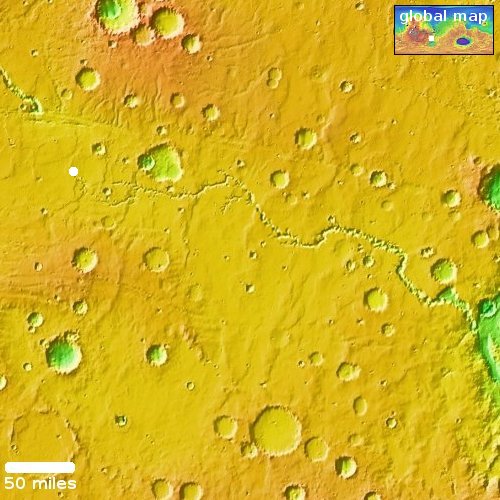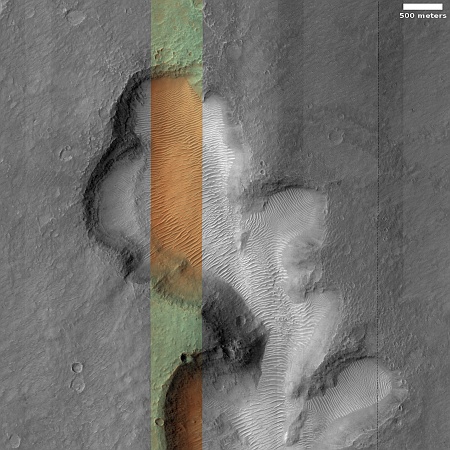The strange beginning of a 300-mile-long meandering canyon on Mars

Today’s cool image will be unlike most cool images, in that we will begin not with the image but with the overview map to the right. The long meandering canyon at the center of this map is Nirgal Vallis, a 300-mile long canyon on Mars that eventually drains to the east into a much larger drainage system that runs south-to-north several thousand miles into the Martian northern lowland plains.
At first glance Nirgal Vallis invokes a river system. It starts in the west as several branches that combine to form a single major canyon meandering eastward until it enters that south-to-north system. To our Earth eyes, this canyon suggests it was carved by water flowing eastward, the many drainage routes combining as they flowed downhill.
Today’s the cool image, its location indicated by the white dot, tells us however that liquid water might not have been what created this canyon.
The picture to the right, rotated, cropped, reduced, and sharpened to post here, was taken on September 28, 2024 by the high resolution camera on Mars Reconnaissance Orbiter (MRO). The different colors in the color strip probably represent different types of rock and sand, with the orange in the canyon dust and fine sand (thus the dunes), and the green on the plateau coarser rocks and bedrock.
The science team labels this “Nirgal Vallis Headwaters.” We are looking at the very start of a long 300-mile-long canyon. It however is very unlike the headwaters of a river system, which is usually a very small creek or stream or even a simple trickle coming out of the ground. With water-formed systems the channel grows slowly from that trickle to a wider river.
Here however Nirgal begins suddenly, in a wide canyon. As noted by Mars Express image release from 2019,
Nirgal Vallis is a typical example of a feature known as an amphitheatre-headed valley. As the name suggests, rather than ending bluntly or sharply, the ends of these tributaries have the characteristic semi-circular, rounded shape of an Ancient Greek amphitheatre. Such valleys also typically have steep walls, smooth floors, and, if sliced through at a cross-section, adopt a ‘U’ shape.
All of these geological features suggest the slow carving of the canyon by glaciers, not liquid water. Moreover, the orbital images suggest that some of that carving might have occurred underground. Though this image captures the beginning of Nirgal Vallis, the overview map shows further canyons to the west that are aligned with it. It is as if the ice flowed underground, and eventually pulled the surface away to reveal that underground canyon along most of its length. Only in the west, where the ice flow was smaller does some of that roof remain.
Where this ice came from remains a mystery. This location is mostly in the dry equatorial regions of Mars, though its southern edge slips into the mid-latitude regions where many glaciers are still found. The possibility that water ice was once prevalent here suggests once again that Mars has undergone many significant changes in climate.
On Christmas Eve 1968 three Americans became the first humans to visit another world. What they did to celebrate was unexpected and profound, and will be remembered throughout all human history. Genesis: the Story of Apollo 8, Robert Zimmerman's classic history of humanity's first journey to another world, tells that story, and it is now available as both an ebook and an audiobook, both with a foreword by Valerie Anders and a new introduction by Robert Zimmerman.
The print edition can be purchased at Amazon or from any other book seller. If you want an autographed copy the price is $60 for the hardback and $45 for the paperback, plus $8 shipping for each. Go here for purchasing details. The ebook is available everywhere for $5.99 (before discount) at amazon, or direct from my ebook publisher, ebookit. If you buy it from ebookit you don't support the big tech companies and the author gets a bigger cut much sooner.
The audiobook is also available at all these vendors, and is also free with a 30-day trial membership to Audible.
"Not simply about one mission, [Genesis] is also the history of America's quest for the moon... Zimmerman has done a masterful job of tying disparate events together into a solid account of one of America's greatest human triumphs."--San Antonio Express-News

Today’s cool image will be unlike most cool images, in that we will begin not with the image but with the overview map to the right. The long meandering canyon at the center of this map is Nirgal Vallis, a 300-mile long canyon on Mars that eventually drains to the east into a much larger drainage system that runs south-to-north several thousand miles into the Martian northern lowland plains.
At first glance Nirgal Vallis invokes a river system. It starts in the west as several branches that combine to form a single major canyon meandering eastward until it enters that south-to-north system. To our Earth eyes, this canyon suggests it was carved by water flowing eastward, the many drainage routes combining as they flowed downhill.
Today’s the cool image, its location indicated by the white dot, tells us however that liquid water might not have been what created this canyon.
The picture to the right, rotated, cropped, reduced, and sharpened to post here, was taken on September 28, 2024 by the high resolution camera on Mars Reconnaissance Orbiter (MRO). The different colors in the color strip probably represent different types of rock and sand, with the orange in the canyon dust and fine sand (thus the dunes), and the green on the plateau coarser rocks and bedrock.
The science team labels this “Nirgal Vallis Headwaters.” We are looking at the very start of a long 300-mile-long canyon. It however is very unlike the headwaters of a river system, which is usually a very small creek or stream or even a simple trickle coming out of the ground. With water-formed systems the channel grows slowly from that trickle to a wider river.
Here however Nirgal begins suddenly, in a wide canyon. As noted by Mars Express image release from 2019,
Nirgal Vallis is a typical example of a feature known as an amphitheatre-headed valley. As the name suggests, rather than ending bluntly or sharply, the ends of these tributaries have the characteristic semi-circular, rounded shape of an Ancient Greek amphitheatre. Such valleys also typically have steep walls, smooth floors, and, if sliced through at a cross-section, adopt a ‘U’ shape.
All of these geological features suggest the slow carving of the canyon by glaciers, not liquid water. Moreover, the orbital images suggest that some of that carving might have occurred underground. Though this image captures the beginning of Nirgal Vallis, the overview map shows further canyons to the west that are aligned with it. It is as if the ice flowed underground, and eventually pulled the surface away to reveal that underground canyon along most of its length. Only in the west, where the ice flow was smaller does some of that roof remain.
Where this ice came from remains a mystery. This location is mostly in the dry equatorial regions of Mars, though its southern edge slips into the mid-latitude regions where many glaciers are still found. The possibility that water ice was once prevalent here suggests once again that Mars has undergone many significant changes in climate.
On Christmas Eve 1968 three Americans became the first humans to visit another world. What they did to celebrate was unexpected and profound, and will be remembered throughout all human history. Genesis: the Story of Apollo 8, Robert Zimmerman's classic history of humanity's first journey to another world, tells that story, and it is now available as both an ebook and an audiobook, both with a foreword by Valerie Anders and a new introduction by Robert Zimmerman.
The print edition can be purchased at Amazon or from any other book seller. If you want an autographed copy the price is $60 for the hardback and $45 for the paperback, plus $8 shipping for each. Go here for purchasing details. The ebook is available everywhere for $5.99 (before discount) at amazon, or direct from my ebook publisher, ebookit. If you buy it from ebookit you don't support the big tech companies and the author gets a bigger cut much sooner.
The audiobook is also available at all these vendors, and is also free with a 30-day trial membership to Audible.
"Not simply about one mission, [Genesis] is also the history of America's quest for the moon... Zimmerman has done a masterful job of tying disparate events together into a solid account of one of America's greatest human triumphs."--San Antonio Express-News



Thanks for keeping the mystery alive Bob. What a crazy place
It’s almost like Mars serves some kind of purpose.